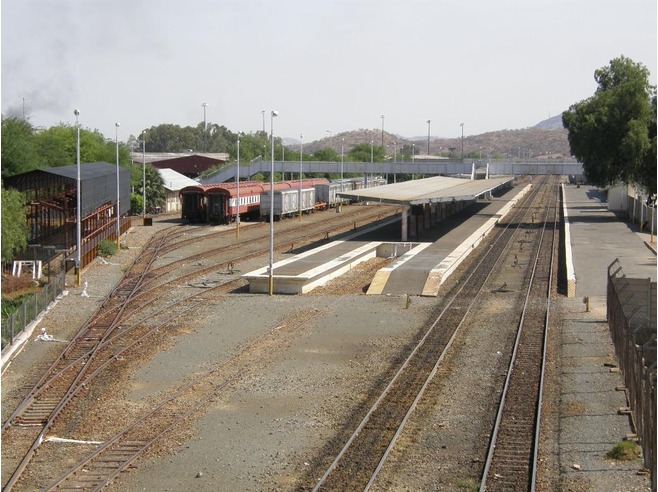Namibia: Namibia Transportation Profile
2015/01/24

Namibia's road network is regarded as one of the best on the continent; road construction and maintenance adheres to international standards.
The country's more than 44,500 kilometres (27,700 mi) roads are administered by the Roads Authority, a state-owned enterprise established by Act #17 of 1999.
Due to low traffic volumes the majority of roads are not tarred. The distribution of road surfaces is:
6,664 kilometres (4,141 mi) standard bitumen road
412 kilometres (256 mi) low-volume bitumen road. These roads have the same base layer as gravel roads but are covered with a thin layer of bitumen to reduce maintenance cost and dust formation.
25,710 kilometres (15,980 mi) standard gravel road, covered with imported gravel.
11,460 kilometres (7,120 mi) earth-graded road. These roads are built by clearing the vegetation and blading the surface. Compaction is achieved by the traffic using the road. Some of these roads are not graded at all but just consist of earth or sand tracks separated by vegetation. These tracks are in use where a daily usage of less than five vehicles is expected.
288 kilometres (179 mi) salt road. These roads consist of concentrated salt water and gypsum-rich material. They are only built near the Atlantic coast inside the mist belt.
The major highways in Namibia are:
B1 from Noordoewer (South African border) to Oshikango (Angolan border), 1694 km
B2 from Walvis Bay to Okahandja, 285 km
B3 from Nakop (South African border) to Grünau, 324 km
B4 from Lüderitz to Keetmanshoop, 351 km
B6 from Windhoek to Buitepos (Botswana border), 335 km
B8 from Otavi to Katima Mulilo (Zambian border), 837 km
As of December 2011 there are about 270,000 cars registered in Namibia, almost half of them in the capital Windhoek
Railways in Namibia describes the provision of rail service as a mode of transportation in Namibia. Rail service in Namibia is provided by TransNamib. Namibia's rail network consists of 2,382 route-km of tracks, however this number continues to increase as the rail infrastructure continues to grow.
Namibia has a history of more than 100 years of railway service. During the colonialisation by the German Empire between 1894 an 1915, a number of railways were built, some of which are still in service today.
Early development
The building of German South-West Africa 's railways began with a small mining rail line at Cape Cross in 1895. The first major railway project was started in 1897 when the German Colonial Authority build the "Staatsbahn" (state railway) from Swakopmund to Windhoek. By 1902 the line was completed. Parallel to this government initiative the Otavi Mining and Railway Company (O.M.E.G.) was established which built a line from Swakopmund to Tsumeb via Otavi between 1903 and 1906, and a branch from Otavi to Grootfontein in 1907/08.
The German colonial railway was taken over by the Railways of South Africa after World War I, and linked into the network of South Africa. After the independence of Namibia, TransNamib took control of the national rail network that operates on 3 ft 6 in (1,067 mm).
African Rail Conference
Plans to integrate the railways of Africa to facilitate trade were discussed at the Africa Rail conference in Johannesburg, South Africa in August 2002. The move forms part of the New Partnership for Africa's Development (NEPAD), a programme aimed at economic renaissance.
The railways were built by former colonial powers, but were not built to advance African interests. Plans were put into place to link the three parallel east-west lines in Angola and to connect the Angolan network to that of Namibia and hence to South Africa.
The strategic positioning of Maputo rail and port infrastructure indicated that the network should be promoted as the primary corridor serving Zimbabwe, Zambia, Democratic Republic of Congo, Swaziland, and South Africa's Mpumalanga province.
South Africa's transport minister, Mr Abdulah Omar, said Africa needed to integrate its railway systems to form an internationally-competitive network. Experts said this could involve leasing locomotives and wagons, becoming involved as concessionaires and consultants, and participating in joint ventures.
Current Railway Lines
Windhoek-Kranzberg
The railway line from Windhoek to Kranzberg is 210 kilometres (130 mi) long and was completed in 1902.
Windhoek - capital - junction
Okahandja
Karibib - proposed cement works
Kranzberg - junction Tsumeb v Windhoek.
Kranzberg-Walvis Bay
The railway line from Kranzberg to Walvis Bay is 201 kilometres (125 mi) long. The section between Kranzberg and Swakopmund was completed in 1902. In 1914 an extension to Walvis Bay was commissioned; the rails were laid close to the shore of the Atlantic Ocean. In 1980 this extension was replaced by an alternative route behind the dunes that allowed for higher axle load.[1]
Kranzberg - junction Tsumeb v Windhoek.
Usakos
Arandis - crossing loop
Swakopmund
Walvis Bay - port
Kranzberg-Otavi
The railway line from Kranzberg to Otavi is 328 kilometres (204 mi) long and was completed in 1906.
Kranzberg - junction Tsumeb v Windhoek.
Omaruru
Kalkfeld - short siding
Otjiwarongo - junction for Outjo
Otavi
Otavi-Grootfontein
The railway line from Otavi to Grootfontein is 91 kilometres (57 mi) long and was completed in 1908.[1]
Otavi - junction for Grootfontein
Grootfontein - branch terminus.
Seeheim-Aus
The railway line from Seeheim to Lüderitz is 318 kilometres (198 mi) long. The connection between Lüderitz and Aus was completed in 1906, the extension to Seeheim was completed in 1908.[1] Currently the service between Aus and Lüderitz is decommissioned, and there is no regular passenger service between Seeheim and Aus.
Seeheim - junction for Lüderitz
Aus
Nakop-Windhoek
The railway line from Nakop to Windhoek is 869 kilometres (540 mi) long. The section between Karasburg and Keetmanshoop was completed in 1909. In 1912 the 500 kilometres (310 mi) connection between Karasburg and Windhoek was completed, and the extension to Upington (South Africa) was built in 1915
South Africa Upington
Namibia South Africa Nakop border
Karasburg
Keetmanshoop
Tses
Rehoboth
Windhoek - capital - junction
Otjiwarongo-Outjo
The railway line from Otjiwarongo to Outjo is 69 kilometres (43 mi) long. The first 26 kilometres (16 mi) were completed under the German colonial administration in 1914/1915; the railway line was named Amboland Railway in reference to the territory of the Ovambo people. The link to Outjo was completed in 1921 under South African rule.
Otjiwarongo - junction for Outjo
Outjo - railhead
Windhoek-Gobabis
The railway line from Windhoek to Gobabis is 228 kilometres (142 mi) long and was completed in 1930.
Windhoek - capital - junction
Neudamm
Omitara
Gobabis - branch railhead
Otavi-Oshikango
In 2005, an 89 km section of new Northern Railway from Tsumeb to Oshivelo was opened by President Sam Nujoma, as part of the "Northern Extension" of the railway link from Kranzberg to Otavi. Construction on the project's second phase, a 59 km stretch from Ondangwa to Oshikango on the Angolan border at a cost of about N$329m, was scheduled to be completed by December 2007. Ondangwa Station opened in 2006 for freight.
In phase 3, a 58 km branch from Ondangwa to Oshakati was constructed at an estimated cost of N$220m, for completion in December 2008. For the future a connection from Oshikango to a point near Cassinga is planned on Angola's southern railway system.
The Ondangwa-Oshikango line was officially opened by President Hifikepunye Pohamba in July 2012. In order to keep system operational and safe, provincial governor Usko Nghaamwa implored local residents to stop stealing railroad ties and sections of the wire fence.
Otavi - junction for Grootfontein
Tsumeb
Ondangwa - junction
Oniipa road bridge.
Oshakati
Namibia Angola Oshikango - border post - current railhead
Historic Railway Lines
Apart from a number of short rail connections built by mining companies, the following railway links are decommissioned:
20 kilometres (12 mi) Cape Cross Mine Railway, 610 mm (2 ft) gauge. The first railway line in South-West Africa, built in 1895/96
18 kilometres (11 mi) Walvis Bay Railway, 610 mm (2 ft) gauge, completed in 1899. The line linked the port of Walvis Bay to Rooikop
567 kilometres (352 mi) Otavibahn, a 600 mm (1 ft 11 5⁄8 in) private railway built by the Otavi Mining and Railway Company between 1903 and 1906 to connect the mines at Tsumeb to the town of Swakopmund. In 1908 the line was extended by 91 kilometres (57 mi) to reach Grootfontein. The Otavibahn was the longest 600 mm (1 ft 11 5⁄8 in) gauge railway in the world at its time of construction.[8]
119 kilometres (74 mi) a 600 mm (1 ft 11 5⁄8 in) industrial line linking Kolmanskop with Bogenfels, completed 1913.
This was the only rail link in Namibia ever electrified. The rail track does not exist anymore.
26 kilometres (16 mi) Amboland Railway, Otjiwarongo - Outjo, 1914-1915
- Namibia News
-
- AFGHANISTAN: UNWTO: International tourism – strongest half-year results since 2010
- BOTSWANA: Why governments need to support the financial sector to meet the unserved needs of smallholder farmers
- BOTSWANA: International Arrivals To Africa Reach More Than 18 Million In 2017
- BOTSWANA: Africa: USA-Africa - No Policy? Bad Policy? or Both?
- BOTSWANA: Africa: U.S. State Department To Get Experienced Diplomat in Key Africa Post
- BOTSWANA: Africa’s economic growth in 2016 was driven by East Africa
- Trending Articles
-
- SOUTH AFRICA: Nigeria and South Africa emerge from recession
- UZBEKISTAN: Former deputy PM named Uzbekistan Airways head
- AUSTRALIA: Western Australia joins two-thirds of country to ban fracking
- BAHRAIN: Bahrain issues new rules to encourage fintech growth
- BAHRAIN: Aluminium Bahrain’s Line 6 Expansion Achieves 25 Percent Completion
- CHINA: Chinese-supported infrastructure projects change Zambia's landscape






.gif?1356023993)

